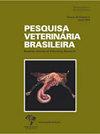Oral affections in an ex situ population of marsh deer (Blastocerus dichotomus): a retrospective study (1990-2020)
IF 0.8
4区 农林科学
Q3 VETERINARY SCIENCES
引用次数: 0
Abstract
ABSTRACT: Oral diseases are limiting to health, welfare, and conservation practices, especially in the case of endangered animals. In this retrospective study, a survey on oral health-related conditions noted in the clinical records for 261 deer comprised in an ex situ population of the Marsh Deer Conservation Center (CCCP) over 30 years (1990-2020) was carried out. Of these, 49 (18.77%) marsh deer (31 females - 63.27% and 18 males - 36.73%) had clinical oral affections; the affected deer’s mean age was 8.9 years. Logistic regression analysis was performed, and the variable age was significantly associated with the presence of dental affections. Thus, with a change in the age category, a deer had eight times the chance of manifesting oral affections; therefore, age can be considered a risk factor for the manifestation of oral affections in the species. Increased facial volume (65.3%), accumulation of food in the mouth (36.7%), tooth loss (22.4%), fistulas (22.4%), mucosal or palatal lesions (22.4%), tooth wear (20.4%), and tooth root exposure (18.3%) were the most frequently recorded lesions. The relatively high occurrence of oral affections in Blastocerus dichotomus reiterates the importance of oral health care when deer are kept in human care.沼泽鹿(Blastocerus dichotomus)迁地种群的口腔情感:回顾性研究(1990-2020)
摘要:口腔疾病对健康、福利和保护措施的影响越来越大,尤其是对濒危动物。在这项回顾性研究中,对沼泽鹿保护中心(CCCP)迁地种群中261只鹿的口腔健康状况进行了30多年(1990-2020年)的临床记录调查。其中49只沼泽鹿(18.77%)有临床口腔疾病,其中雌性31只(63.27%),雄性18只(36.73%);患病鹿的平均年龄为8.9岁。经Logistic回归分析,年龄变量与牙病存在显著相关。因此,随着年龄类别的变化,鹿有8倍的机会表现出口头情感;因此,年龄可以被认为是该物种口腔情感表现的一个危险因素。面部体积增大(65.3%)、口腔内食物堆积(36.7%)、牙齿脱落(22.4%)、瘘管(22.4%)、粘膜或腭病变(22.4%)、牙齿磨损(20.4%)和牙根外露(18.3%)是最常见的病变。相对较高的发生口腔的影响,在二叉芽球鹿重申口腔保健的重要性,当鹿保持在人类护理。
本文章由计算机程序翻译,如有差异,请以英文原文为准。
求助全文
约1分钟内获得全文
求助全文
来源期刊

Pesquisa Veterinaria Brasileira
农林科学-兽医学
CiteScore
1.30
自引率
16.70%
发文量
41
审稿时长
9-18 weeks
期刊介绍:
Pesquisa Veterinária Brasileira - Brazilian Journal of Veterinary Research (http://www.pvb.com.br), edited by the Brazilian College of Animal Pathology in partnership with the Brazilian Agricultural Research Organization (Embrapa) and in collaboration with other veterinary scientific associations, publishes original papers on animal diseases and related subjects. Critical review articles should be written in support of original investigation. The editors assume that papers submitted are not being considered for publication in other journals and do not contain material which has already been published. Submitted papers are peer reviewed.
The abbreviated title of Pesquisa Veterinária Brasileira is Pesqui. Vet. Bras.
 求助内容:
求助内容: 应助结果提醒方式:
应助结果提醒方式:


